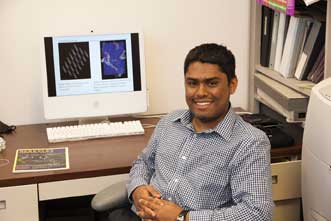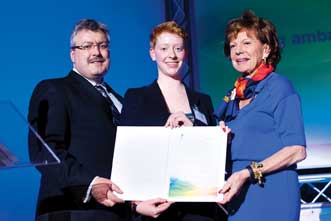
Bright Lights in the Bio(photonics)sphere
As students around the world head back to school, let’s take a moment to acknowledge some of the work being carried out by the under-20 crowd. Last month, in a news story, we highlighted the work of Arjun Nair, the 16-year-old high school student from Calgary, Alberta, Canada, who won top national honors in the 2013 Sanofi BioGENEius Challenge Canada (SBCC) for an experimental therapy that deploys gold nanoparticles in the fight against cancer. But Nair isn’t the only teen working toward biophotonics advances. The following three young people are among those who will likely help to shape the future of biophotonics and, in so doing, help shape all our futures.
Finding Cancer Cells: Kelly Zhang
For her method to help surgeons visualize tumor margins by staining cancer cells selectively with fluorescent dyes, the 17-year-old Zhang was named a finalist in Intel Science Talent Search (Intel STS) 2013. She is a student at The College Preparatory School in Oakland, Calif.
The Intel STS is a precollege science competition; alumni have made extraordinary contributions to science and hold more than 100 of the world’s most coveted science and math honors, including the Nobel Prize and the National Medal of Science. The Intel STS recognizes and rewards 300 students, as well as their schools, as semifinalists each year. From that pool, 40 finalists are invited to Washington every March for final judging as well as to display their work to the public, meet with notable scientists and compete for $630,000 in awards, including the top award of $100,000.
For her entry, Zhang adapted drug-delivery nanotechnology concepts to derive a nanoscale imaging agent from a combination of the protein albumin and fluorescent dye, according to Intel. She then incubated a variety of cell lines with the new stain and found that tumor cells became more luminous than healthy cells. She believes her study will contribute to the improvement of cancer imaging techniques for surgeons resecting tumors.
Zhang also has created BioLabScope, a website that seeks to spread the world of science to high school students. The site (www.biolabscope.com) features videos on basic lab science and biology applications that aren’t always taught in high school classrooms.
• Dr. Mark Foster, an assistant professor in the department of electrical and computer engineering at Johns Hopkins’ Whiting School of Engineering, received a five-year, $400,000 National Science Foundation Faculty Early Career Development (CAREER) Award for his high-speed IR imaging system, which is designed to continuously record images at a rate of more than 100 million fps – 100 times more rapidly than current technology allows. It could eventually be used for cell screening for disease prediction or to observe a scientific phenomenon that occurs at a very fast rate.
• Dr. Björn Lillemeier and Dr. Axel Nimmerjahn of the Waitt Advanced Biophotonics Center each received
$1.5 million from the National Institutes of Health (NIH) as two of only 51 recipients of the 2012 NIH Director’s New Innovator Award. Lillemeier develops optical microscopy techniques that visualize the molecular organization of plasma membrane signaling in live cells and will use the award to boost his understanding of how cellular communication is controlled in space and time. Nimmerjahn creates and develops research tools for dissecting glial cell function in both the intact healthy and the diseased brain. He will use the prize to support his research into microglia, resident immune cells in the brain involved in all brain pathologies.
• Dr. James J. Wynne, Dr. Rangaswamy Srinivasan and Dr. Samuel Blum, all IBM scientists, received the US National Medal of Technology and Innovation from President Barack Obama for the development of excimer lasers for medical use. The award recognizes the impact that excimer lasers have made in medical procedures such as lasik eye surgery.
• Dr. Tomasz Tkaczyk, a bioengineering assistant professor at Rice University, won Edmund Optics’ 2012 Norman Edmund Inspiration Award for his low-cost, portable optical systems for global health applications. Tkaczyk received $5000 in Edmund Optics products, in addition to the $10,000 in goods he received from the company as a first-place winner in its 2012 Higher Education Grant Program. His work involves advancing microscopy for in vivo detection of cancer and infectious diseases.
STEM Outreach: Ritankar Das
At 18, Das is the youngest University Medalist in the University of California, Berkeley’s history; the annual award includes a $2500 scholarship and is given to the year’s top graduating senior. In his mere three years at Berkeley, Das double-majored in bioengineering and chemical biology with a minor in creative writing. Next, he’s off to Oxford University to pursue a master’s degree in biomedical engineering, and after that he will take up study at MIT, where he has already been admitted to the Ph.D. program in chemistry.

Courtesy of Michael Barnes/UC Berkeley.
Das is also the founder and chairman of See Your Future, a student-run nonprofit that uses digital learning techniques such as visual demonstrations on YouTube and tutoring via Skype to attract disadvantaged students to careers in STEM (science, technology, engineering and mathematics) fields. The program operates in the Berkeley community currently, but Das would like it to expand nationwide.
He also has formed a campus chapter of the American Chemical Society, according to the school, and founded the Berkeley Chemical Review. He and Marcin Majda, professor and undergraduate dean in the College of Chemistry, are developing a book on education reform with contributions from Fortune 50 CEOs, Nobel laureates, US cabinet secretaries and university presidents.
The University Medal is not his first award. Das has won more than 40 awards, totaling more than $300,000, including a graduate research fellowship from the National Science Foundation, and he has conducted research projects at the likes of the Energy Biosciences Institute and the US Department of Energy.
Liaising for Light: Jana Huisman
As a young girl in the Netherlands, Jana Huisman had a curiosity about the world around her that led her to study physics. That same curiosity now drives the 18-year-old’s interest in photonics, and she’s putting it to good use in her new appointment as Young Ambassador for Photonics Education.
Huisman, now in her third year of undergraduate studies at the University of Bonn in Germany, was officially given the role this spring by European Commissioner Neelie Kroes at the annual meeting of Photonics21, the European technology platform for photonics. The position was created by Photonics21 and the European Commission.

Jana Huisman (center) accepts the Young Ambassador for Photonics Education award from Photonics21 President Dr. Michael Mertin and European Commissioner Neelie Kroes at the Photonics21 annual meeting. Courtesy of Photonics21.
In her undergraduate work, Huisman is studying the interaction between light and matter. “There’s a connection to life,” she said. “There are photonics applications in environmental and health sciences, and with photovoltaics, we can imitate nature by getting energy from sunlight.”
The ambassadorship was created to help stimulate interest in studying photonics, one of Europe’s key enabling technologies. The European photonics industry makes up 20 percent of the global market, and the European Union is home to more than 5000 SMEs (small- and medium-sized enterprises) in the sector, Kroes pointed out at the meeting. At the award ceremony, Kroes asked Huisman to join, as an observer, her group of Young Advisors on the Digital Agenda, which provides insight into digital communication technologies and applications.
In her role, Huisman will visit three European research institutes this year to observe photonics research in action. “I’m looking forward to learning about what they are doing, bringing my enthusiasm, and then writing and blogging about it – hopefully, I can transmit some of that enthusiasm to other students,” Huisman said.
Published: September 2013